Zoom
Trash
Related: Flipped Learning
- Blended Learning
- Nice sites & blogs
- Spring 2017
- Blended Learning
- Metodologías
- Educación
- Education
- Enterprise

Blended Learning Definitions - Christensen Institute : Christensen Institute. For a full overview on blended learning basics and models, visit the Blended Learning Universe, an online hub curated by the Christensen Institute.
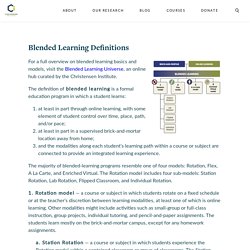
The definition of blended learning is a formal education program in which a student learns: at least in part through online learning, with some element of student control over time, place, path, and/or pace;at least in part in a supervised brick-and-mortar location away from home;and the modalities along each student’s learning path within a course or subject are connected to provide an integrated learning experience. The majority of blended-learning programs resemble one of four models: Rotation, Flex, A La Carte, and Enriched Virtual. The Rotation model includes four sub-models: Station Rotation, Lab Rotation, Flipped Classroom, and Individual Rotation. 1.
6 Blended Learning Models: When Blended Learning Is What’s Up For Successful Students - eLearning Industry. Which Blended Learning Model is Best for Your Classroom? - Advancement Courses. During the State of the Union Address, President Obama announced the Computer Science for All initiative, an exciting and ambitious plan to increase access to technology and empower students.
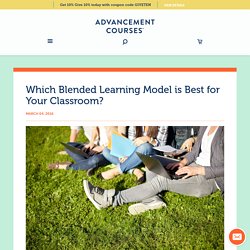
So, where do we begin? Last week, we discussed the shift from the traditional classroom to a technology-embedded, personalized blended learning environment as one way to increase computer science instruction. Blended Learning Definition. The term blended learning is generally applied to the practice of using both online and in-person learning experiences when teaching students.
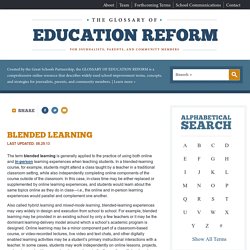
In a blended-learning course, for example, students might attend a class taught by a teacher in a traditional classroom setting, while also independently completing online components of the course outside of the classroom. In this case, in-class time may be either replaced or supplemented by online learning experiences, and students would learn about the same topics online as they do in class—i.e., the online and in-person learning experiences would parallel and complement one another. Also called hybrid learning and mixed-mode learning, blended-learning experiences may vary widely in design and execution from school to school. What is Blended Learning? A quote from the former US Secretary of Education The goal of blended courses is to join the best features of in-class teaching with the best features of online learning to promote active independent learning.

Blended courses are courses in which a significant portion of the learning activities have been moved online, and time traditionally spent in the face-to face (FTF) classroom is reduced but not eliminated. Using computer-based technologies, instructors use the blended model to redesign some lecture or lab content into new online learning activities, such as case studies, tutorials, self-testing exercises, simulations, and online collaborations. There is no one model for blended learning. Depending on the course and instructor, the amount of time student spends online and face-to-face classroom will vary. Top EdTech Update Gamification STEM Content for November, 2016. Online and face-to-face spaces blend to create a today’s classroom.

Most schools have physical buildings. For purposes of this article, we’ll call these “the bricks.” Also, schools also have online spaces where students work and collaborate. We’ll call these, “the clicks.” When bricks and clicks combine into a powerful learning experience for students, we have an effective blended classroom. This blog post is sponsored by PowerSchool Learning. In the final analysis, don’t think that blending doesn’t apply to your classroom. PowerSchool Learning is my classroom’s Learning Management System (LMS). Blended Learning Tip #1: Use Videos To Supplement Face-to-Face Instruction In flipped learning, students watch videos at home. Why I Use In-Flip Teaching. The in-flip method is similar except students watch the videos a during class. Help when they need it. Video tutorials help students work at their own pace. Personalize Learning and Save Time. There’s an old movie, “Click,” with Adam Sandler. 5.
Top EdTech Update Gamification STEM Content for November, 2016. Favorite Blended Learning Tools - Go - Teacher Tech. Blended 2.0 shifts learning in schools. A third-grader studying the Spanish settlement of California found a virtual tour online and shared the trip with her classmates by slipping a smartphone into a Google Cardboard viewing device.
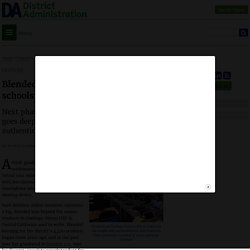
Such limitless online resources represent a big, blended leap beyond the essays students in Coalinga-Huron USD in Central California used to write. Blended learning for the district’s 4,400 students began three years ago, and in the past year has gravitated to blended 2.0, says Joe Casarez, associate superintendent for instructional services. “If you define blended learning in the first iteration as a combination of technology and print,” Casarez says, “then what we are seeing when you marry 2.0 personalization with the Common Core standards are more authentic activities in the classroom.”
A survey of 1,381 students in the district showed nearly 74 percent were more engaged, and 89 percent agreed they could solve problems or create presentations by researching online, he adds. The result? Blended Learning & Flipped Classroom. Blended Learning, Flipped Classroom - What's the Difference? Over the past twenty years, advances in the areas of web and video content delivery have aided the growth of technology-based teaching methodologies, including the flipped class model, blended learning, MOOCs, and more.
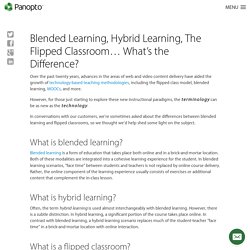
However, for those just starting to explore these new instructional paradigms, the terminology can be as new as the technology. In conversations with our customers, we’re sometimes asked about the differences between blended learning and flipped classrooms, so we thought we’d help shed some light on the subject. Is blended learning the same as flipped classroom? What is blended learning. The Ultimate Guide to Blended Learning Models. Have you heard of Blended Learning?

Youre probably rolling your eyes at the screen. If you've been anywhere in the remote vicinity of the education realm in the past couple years, you've heard of and have probably seen efforts to blend online and offline learning in your classrooms and schools. Blended Learning Models. Blended Learning: 4 Blended Learning Models. Favorite Blended Learning Tools - Go - Teacher Tech. Blended Learning Definitions. The definition of blended learning is a formal education program in which a student learns: at least in part through online learning, with some element of student control over time, place, path, and/or pace;at least in part in a supervised brick-and-mortar location away from home;and the modalities along each student’s learning path within a course or subject are connected to provide an integrated learning experience.
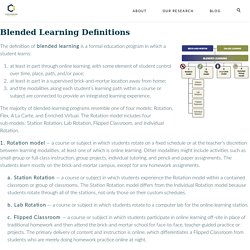
The majority of blended-learning programs resemble one of four models: Rotation, Flex, A La Carte, and Enriched Virtual. The Rotation model includes four sub-models: Station Rotation, Lab Rotation, Flipped Classroom, and Individual Rotation. 1. Rotation model — a course or subject in which students rotate on a fixed schedule or at the teacher’s discretion between learning modalities, at least one of which is online learning.
A. B. C. D. Educational Leadership:Technology-Rich Learning:The Basics of Blended Instruction. The Definition of Blended Learning. Our Vision Leveraging technology, personalizing learning, empowering teachers, accelerating results, elevating our community Our Objective To transform our schools, over the course of the next five years, into blended learning environments Our Rationale Our primary purpose for implementing a blended learning approach is to continue to increase student achievement, while ensuring our young people are prepared for post-secondary learning and careers as they learn in a 21st Century environment.

Blended learning will revolutionize learning for our students.